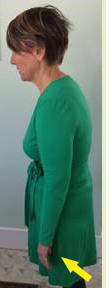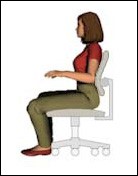Let Posture Be Your Guide
I took up a new sport, speed skating. This is the short-track version where you wear long-bladed skates to speed around a hockey rink. Think Apollo Ono and the Winter Olympics. I am not an elite athlete nor do I like dangerous activities, but something in the sport drew me in.
In my mind’s eye, I am crouched over and flying around the corners. As I skate, the speed is exhilarating! But when my coach showed me video of my skating, I was crestfallen. Surely, I was not that pokey person cruising along in an upright position? I tell this story to illustrate the fact that we don’t always have an accurate perception of our posture.
During ergonomic evaluations, I take a photo of the person’s posture while he or she works. So often, the person is surprised by the photo. He or she may be twisted, slouched, stretched or reaching, and yet perceive himself as having picture-perfect posture.
Awkward posture is one of the biggest risk factors for ergonomic injuries. Awkward postures increase the forces on the body, especially in the low back. For example, a person picking up a pencil from the floor while bending at the waist has twice the amount of low back force as someone lifting a 40-pound load with good technique.
Awkward postures are often caused by a poorly designed workstation. Some examples are desks too high, chairs too low, overhead reaches to shelves, retrieving items from below-knee level, and constrained spaces. Unconscious behavior is another cause of awkward postures—crossing legs while sitting, slumping shoulders forward while standing, curling wrists inward while sleeping.


So how do we bring reality closer to our perceptions? Mirrors can help, but are not practical in many work environments. Improving your posture, and then noting reference points in the work area can be a simple and easy way. For example, when I work in good posture, I see the top of my monitor aligned with the top of my cubicle, or when I walk from the parking lot to my building, my palms are facing inwards toward my thighs and not “monkey hands”. Note how the hands are facing towards the back when in a slouched posture, and the hands face inwards or only a quarter-turn to the back when standing or walking with better posture.
It is not always easy to change unconscious behavior associated with poor posture. Good working posture is a worthy goal. I encourage you to review your own posture throughout the day.

When sitting, “neutral posture” is also the goal. We won’t always be perfect like the drawing here, but eliminating the awkward reaches and twisting can make a huge difference throughout a workday. MEMIC customers can check out all of our ergonomic resources in the Safety Director including videos and checklists.
